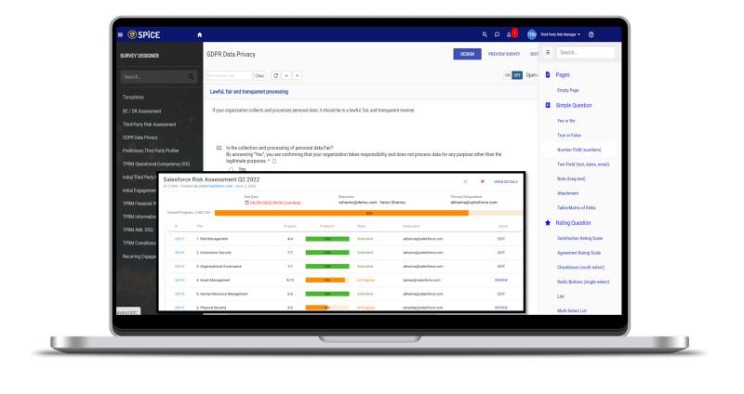The multifaceted challenges inherent in managing vendor risk in today’s global supply networks are not additive; they’re multiplicative. It was hard enough for enterprises to understand their own business risk, but with increasingly complex supply-chains involving product, data and services networks, the complexity of assessing and mitigating risks is orders of magnitude higher. Add to this the evolving regulatory landscapes including current and upcoming data privacy regulations, geo-political risks, and evolving sub-contractor or fourth party risk associated with each vendor, and you have yourself an ever-shifting risk minefield.
With AI and automation, it’s possible—easy even—to navigate this minefield.
- Automation: Reduces manual effort in routine risk management tasks, ensures consistency in risk assessment and mitigation processes, and accelerates task completion across stakeholder groups.
- Artificial Intelligence: Continuously assists and augments all risk assessment and mitigation efforts by analyzing vast and complex external and internal data to identify or predict potential risks, providing real-time insights, and offering recommendations for improvement to make risk assessment efforts more error-proof.
We explore how AI can augment Vendor Risk & Relationship Management (VRRM) in this post.
Impact of AI across all functions of TPRM and Vendor Relationship Management
AI-driven insights support decision-making at every stage of Vendor Risk and Relationship Management (VRRM) and automation makes the functions more repeatable and efficient. Here’s how.
1. Vendor Onboarding and Qualification
Vendor onboarding is a tedious, error-prone bottleneck everywhere. Collection, review and validation of dozens of policies, SOPs (standard operating procedures), plans, certifications, and more can take up a lot of time for multiple stakeholders. Meanwhile, for each vendor you must also evaluate financial stability, ensure regulatory compliance, perform information security due-diligence and assess other potential risks such as technology, operations, business continuity etc.
AI and ML can significantly reduce onboarding time by verifying the authenticity of documents provided by the vendor, automatically ensuring the certification is valid for the term, rating the policies and plans for key criteria and more. For example, if a vendor’s InfoSec policy is out of date (has expired) or is missing key criteria (such as Network security or Application security), or the policy refers to other policies which have not been provided, AI can flag these gaps and bring them to your notice. AI can also recommend additional risk assessments and suggest questions to add to existing assessment questionnaires based on the initial risk questionnaire and materiality of the risks associated with the vendor relationship. Moreover, with integrations with the right external datasets, AI can also help you assess and monitor each vendor for past adverse events that may affect security, operations, compliance or performance.

With AI, onboarding isn’t just faster, it’s smarter. You gain complete visibility into your partners at a fraction of the time.
2. Vendor Deal Finalization and Contracting
Once a vendor has been assessed for risk, AI can help you understand and mitigate risks associated with the contract prior to its finalization by the stakeholders.

Using NLP (natural language processing), AI can extract contract information and help you identify and mitigate contract risks at scale. For example, if the supplier is able to change rates annually and that change is not capped then that introduces commercial risk. Or, if the jurisdiction is not the same as your desired jurisdiction, or if there is no clause allowing for dispute resolution, then there is an additional risk introduced. Key clauses such as Audit Rights, or Indemnity or Non-Disclosure can be validated against legal department approved clauses as well to further mitigate contract risk.
AI can also automate compliance checks against industry regulations as well as legal databases to flag any potential non-compliance issues with industry and/or jurisdiction-specific regulations, helping contract and vendor managers keep pace with dynamic regulatory landscapes and mitigating risk associated with oversight on those fronts.
3. Vendor Risk Monitoring and Performance Evaluation
Traditional vendor risk management relies on initial assessments that can quickly become outdated. In today’s dynamic landscape, hidden threats like sanctions, ownership changes, and unforeseen events can emerge swiftly and leave you exposed to risk.
AI can analyze multiple internal and external sources of data to intelligently assess and continuously monitor risk. Performance to critical SLAs or to contractual obligations are internal sources of data disclosed by the vendors, whereas the market news or adverse events that may affect performance or compliance are external sources of data that vendors may not be able to foresee or be obliged to share. AI helps you:
- Unveil hidden risk: AI scans vast datasets, identifying financial instability, regulatory non-compliance, and ethical lapses before they materialize.
- Predict potential incidents: By identifying patterns within internal and external datasets, AI anticipates issues like data breaches or operational disruptions, allowing you to take proactive measures.
- Optimize decision-making: Real-time insights into vendor performance and compliance empower you to prioritize resources and focus on the most critical risks.

AI’s role goes beyond collecting and analyzing data for risk monitoring. AI can intelligently assess risk across various vendor roles and categories and then create and dynamically adjust domain risk scorecards, trigger alerts, gather trends and generate actionable recommendations for mitigation. This enables vendor managers to proactively and continuously optimize RoI from vendors across the supply chain while protecting their business from risks across multiple domains.
4. Incident Management and Crisis Response
Instead of reacting to unforeseen events and chaos, AI lets you anticipate and outmaneuver it with pattern recognition, risk prediction, and lightning-fast response recommendations. This proactive approach minimizes disruption, shields your reputation, and keeps you in control.
Imagine this: A hurricane is about to hit a key vendor’s delivery hub. AI identifies it (by continuously monitoring for adverse events) and then triggers proactive responses, like:
- Asking vendors about disaster plans and backup sites.
- Generating custom risk assessments to pinpoint vulnerabilities.
- Triggering urgent audits to verify preparedness.
- Alerting key stakeholders immediately, keeping everyone in the loop.
This allows you to sidestep operational snags and reputational damage before they even materialize. Moreover, natural disasters aren’t the only threats AI tackles – it’s your guardian against the entire spectrum of vendor risk domains involving financial and market risk, InfoSec, geopolitical conflicts, and more.
5. Efficient Vendor Relationship Management
From reducing delivery time, cost and friction to improving innovation, optimizing your supply chain RoI involves setting up and monitoring the right SLAs, KPIs, and obligations. AI can help foster stronger vendor relationships by providing insights into vendor performance, identifying areas for improvement, and facilitating collaborative problem-solving. This data-driven approach enhances communication, builds trust, and strengthens your vendor ecosystem.
The Far-Reaching Benefits of AI-Powered VRRM
The implementation of AI in VRRM brings about a multitude of benefits that extend far beyond risk mitigation.
- Improved Decision Making: AI provides real-time insights and predictive analytics, enabling informed decisions that optimize vendor selection, optimize contract negotiations, and minimize supply chain disruptions.
- Reduced Costs: AI helps identify cost-saving opportunities, optimize vendor relationships, and minimize the impact of disruptions.
- Strengthened Reputation: AI-powered VRRM safeguards your reputation by monitoring for incidents, ensuring compliance, and fostering strong vendor relationships.
Outlook for the Future
AI is a catalyst for transformation. In the context of VRRM, AI is the intelligent assistant that transforms it from a reactive process into a strategic advantage.
As AI continues to evolve, its impact on VRRM will grow. Regardless of their industry or domain, organizations that are at the forefront of this transformation will be well-positioned to reap the benefits of improved efficiency, reduced costs, and a strengthened reputation of resilience and trust as their competitive advantage.

